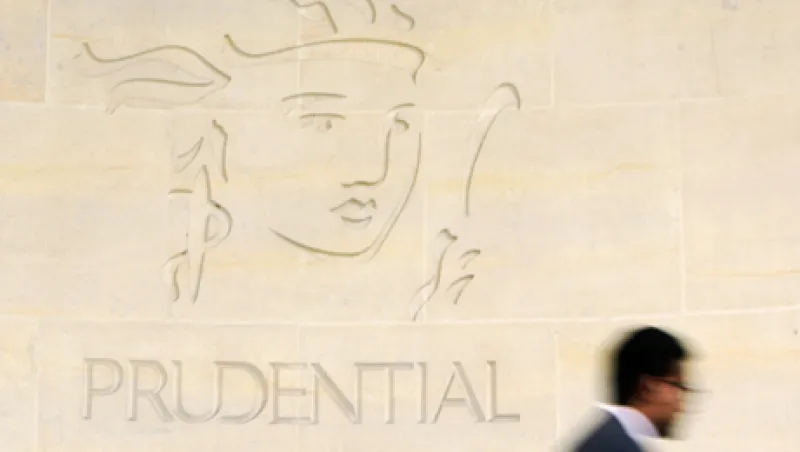Prudential plc’s Asia asset management unit is rebranding as Eastspring Investments in a move that could pave the way for the U.K. insurance giant to sell Asian equity and bond funds to the U.S. and European markets.
Guy Strapp, the Hong Kong–based deputy chief executive officer of Eastspring Investments, which has $80 billion in assets under management, says now is a good time to expand into the U.S. and Europe as global institutional investors are increasingly interested in products that tap into Asia’s growth, not only Asian equities but also corporate bonds.
“The household indebtedness level is in far better shape in Asia than in the U.K. or the U.S.,” says Strapp, adding that low debt levels give Asia the fundamentals for longer-term sustainable growth. “We also think the proposition of our Asian expertise and being able to take it to the U.K. and North America is compelling. There are still very large pools of assets looking for growth returns, and Asia offers plenty of opportunities.”
In the past, Prudential Corporation Asia’s fund business never ventured to offer Asia-focused mutual funds directly in the U.K. and the U.S., while sister companies, M&G Investments in the U.K. and PPM America, Inc., sell primarily domestic products. That void will be filled, however, when Eastspring Investments obtains regulatory approval and begins distributing its products through local U.S. and U.K. banks, Strapp says.
One product area that may draw interest in developed markets is Asian fixed-income funds.
Both China and India are developing large corporate and treasury markets, says Boon Peng Ooi, Eastspring Investment’s Singapore-based head of fixed income, who together with his team manage more than $17 billion in various forms of fixed-income products. “There are a lot of investment opportunities in the Asian bond markets,” says Ooi. “The economies are growing. We see huge opportunities for growth in China and India especially.”
The company may offer various pan-Asian or country-specific strategy funds to prospective investors in developed markets.
Even Japan, which has been suffering sluggish growth and declining stock markets, offers rewards for those who apply the right strategies, says Kevin Gibson, Eastspring Investment’s Singapore-based chief investment officer for equities in Japan, where he and his team manage $3 billion in assets and are looking for undervalued equities that have been oversold by the market and have upside potential.
Gibson has been looking out for oversold stocks in the financial sector and also in areas that were hit by the earthquake last year. While the high yen has hit export competitiveness, it also has presented opportunities for mergers and acquisitions overseas especially for banks, which Gibson likes because many have equities that are trading at historically low price-to-earnings multiples and are using the stronger currency to buy valuable assets abroad. “We see a lot of upside for Japanese stocks,” Gibson says.
Gibson’s Eastspring Investments Japan Dynamic Fund D, for instance, has outperformed the benchmarks. It has delivered 7.6 percent in returns in the past three years, compared to the MSCI Japan Index, which returned 1.8 percent in the same period.
Expanding into developed markets does carry risks for a company that specializes in emerging markets. There is always the possibility that a new and unknown brand like Eastspring Investments may take years to gain market acceptance. Executives remain optimistic, however.
“We see rising domestic consumption in Asia,” deputy CEO Strapp says. “We see a rising middle class. There is a greater level of sustainability in Asia than people would have thought. We think we will have a compelling story to tell in Europe and North America.”
Prudential Corporation Asia’s fund business, the largest onshore manager in the region, has been operating under different names in the region in part because of trademark restrictions arising from U.S.–based Prudential Financial, which also operates in some markets in Asia under various forms of the Prudential name.
“The Eastspring Investments brand removes barriers preventing us from penetrating Asia and European markets efficiently,” says Graham Mason, Eastspring Investment’s Hong Kong–based chief executive. “It also enables us to market our offshore product range worldwide and to enter new territories, such as North America.”
Prudential Corporation Asia’s different fund-business entities in Hong Kong, Japan, Malaysia, Singapore, South Korea, Taiwan, United Arab Emirates and Vietnam are adopting the new name, while its joint ventures in India, China and Hong Kong will remain unchanged.
The funds business employs 2,000 in Asia, including 300 licensed investment professionals. It will continue to manage assets on behalf of Prudential’s life insurance businesses in Asia, where it has joint ventures with India’s largest bank, ICICI Bank, CITIC Bank in China, and Bank of China International in Hong Kong.
U.K.–based Prudential plc has significant operations in Asia, the U.S. and U.K. with about $553 billion in funds under management as of June 2011.
It was founded in 1848, almost four decades earlier than rival Prudential Financial, also known as Prudential Insurance Company of America, which was founded in 1875.
Both have been competing ever since the American company began moving into global markets mid last century. The American company’s asset management arm operates under the brand “PIM” internationally to help differentiate it from the U.K. rival.






